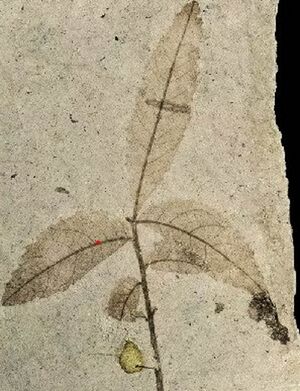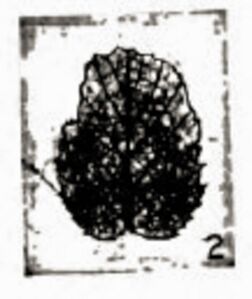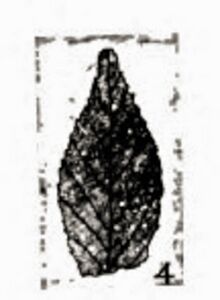Rosa shanwangensis Hu & R.W.Chaney
Fossile-Rose, 1940 - beschrieben von den Botanikern/ described by the botanists/ décrit par les botanistes Hsen Hsu Hu, China und Ralph Works Chaney, USA
Eltern/ parentage/ parents: Botanische Rose/ Wild Rose/ Rosier botanique
Vermutliche Synonyme/ Presumed synonyms/ synonymes présumés: Rosa hilliae Lesq., Rosa dubia C.O.Weber
Die Synonyme wurden beschrieben von den Botanikern/ The synonyms were described by the botanists/ Les synonymes ont été décrits par les botanistes Daniel Isaac Axelrod, USA, Shigeru Miki, Japan, Hermann Engelhardt, Deutschland, Charles Arthur Hollick, USA, Ralph Works Chaney, USA, Frank Hall Knowlton, USA, Gábor (Gabriel) Andreánszky, Ungarn, Oswald von Heer, Schweiz, Theodore Dru Alison Cockerell, USA, Hsen Hsu Hu, China, Toshimasa Tanai, Japan, Władysław Szafer, Polen
Allgemeines • Preface • Remarques
Der Name Rosa shanwangensis leitet sich von der Fundstelle der fossilen Blätter in China in der Provinz Schantung[1], der "Miocene Shanwang Formation"[2] ab. Sie sind ca. 17 Mio. Jahre alt. Sie sind vermutlich die Urahnen von Rosa rugosa Thunb..
The name Rosa shanwangensis is derived from the site in China where the fossilised leaflets were found in the province of Shantung[1], the "Miocene Shanwang Formation"[2]. They are around 17 million years old. They are probably the ancestors of Rosa rugosa Thunb..
Le nom de Rosa shanwangensis vient du lieu de découverte des feuilles fossiles en Chine, dans la province de Schantung[1], la "Miocene Shanwang Formation"[2]. Elles datent d'environ 17 millions d'années. Elles sont probablement les ancêtres de Rosa rugosa Thunb..
Originale Beschreibung • Original description • Description originale
Übersetzung:
Rosa shanwangensis new species
(Plate 24, figs. 2, 3, 4)
Beschreibung——Fiederblättchen eiförmig, am Grund breit keilförmig bis eingeschnitten, Spitze zugespitzt; Länge 2,1 bis 3 cm, Breite 1,3 cm; Nebenblätter in einem Winkel von etwa 30° auseinanderlaufend, außer an der Basis, wo sie mehr ausgebreitet sind, eher gerade bis zum Rand verlaufend, wo sie sich leicht nach oben biegen, kraspedodrom oder mit kleinen Verzweigungen zu den Zähnen; Tertiärblätter undeutlich, unregelmäßig perkurrent; Rand grob und doppelt gesägt; Textur fest.
Unser Material beschränkt sich auf 2 Fiederblättchen, die etwas unterschiedlich geformt sind, sich aber durch den geringen Divergenzwinkel der Sekundärteile ähneln. Es ist nicht möglich, die moderne Verwandtschaft von R. shanwangensis sicher zu bestimmen, aber R. rugosa Thunberg, die derzeit in Shantung lebt, hat ein entsprechendes Verbreitungsgebiet in der Form ihrer Fiederblättchen und ähnelt unseren Exemplaren im geringen Divergenzwinkel der Nebenblätter1. Diese moderne Art ist im Osten bis nach Korea und Japan verbreitet.
Es sind keine eng verwandten fossilen Arten bekannt, obwohl die Gattung im Tertiär Eurasiens und Nordamerikas gut vertreten ist.
Sammlung——National Geological Survey of China, Holotypus Nr. 12; Paratypen Nr. 11, 267.
Original:
Rosa shanwangensis new species
(Plate 24, figs. 2, 3, 4)
Description——Leaflets ovate, broadly cuneate to subcordate at the base, apex acuminate; length 2.1 to 3 cm., width 1.3 cm.; secondaries diverging at angles of about 30° except at the base where they are more spreading, running up rather straight to the margin where they curve up slightly, craspedodrome or with small branches to the teeth; tertiaries obscure, irregularly percurrent; margin coarsely and doubly serrate; texture firm.
Our material is limited to 2 leaflets, which are of somewhat different shape but which resemble each other in the low angle of divergence of the secondaries. It is impossible to indicate certainly the modern affinities of R. shanwangensis, but R. rugosa Thunberg, which is living in Shantung at the present time, has a corresponding range in the shape of its leaflets, and resembles our specimens in the low angle of divergence of the secondaries1. This modern species ranges eastward to Korea and Japan.
There are no closely related fossil species known, although the genus is well represented in the Tertiary of Eurasia and North America.
Collection——National Geological Survey of China, Holotype No. 12; Paratypes Nos. 11, 267.
Traduction:
Rosa shanwangensis new species
(Plate 24, figs. 2, 3, 4)
Description——Les folioles sont ovales, largement cunéiforme à subcordé à la base, apex acuminé ; longueur 2,1 à 3 cm, largeur 1,3 cm ; les secondaires divergent à des angles d'environ 30° sauf à la base où elles sont plus étalées, remontant plutôt droit jusqu'à la marge où elles s'incurvent légèrement, craspedodrome ou avec de petites branches aux dents ; les tertiaires sont obscures, irrégulièrement percurrentes ; marge grossièrement et doublement dentelée ; texture ferme.
Notre matériel est limité à 2 folioles, qui sont de forme quelque peu différente mais qui se ressemblent par le faible angle de divergence des secondaires. Il est impossible d'indiquer avec certitude les affinités modernes de R. shanwangensis, mais R. rugosa Thunberg, qui vit actuellement à Shantung, a une gamme correspondante dans la forme de ses folioles, et ressemble à nos spécimens dans le faible angle de divergence des secondaires1. Cette espèce moderne s'étend vers l'est jusqu'à la Corée et le Japon.
Aucune espèce fossile étroitement apparentée n'est connue, bien que le genre soit bien représenté dans le Tertiaire de l'Eurasie et de l'Amérique du Nord.
Collection——National Geological Survey of China, Holotype No. 12 ; Paratypes Nos. 11, 267.
——
1 See sheets Nos. 31835 and 06122 in the herbarium of Fan Memorial Institute of Biology/ Siehe Blätter Nr. 31835 und 06122 im Herbarium des Fan Memorial Institute of Biology/ Voir les feuilles n° 31835 et 06122 dans l'herbier du Fan Memorial Institute of Biology.
Fundort • Find location • Lieu de découverte
Die fossilen Blätter von Rosa shanwangensis wurden in der Provinz Schantung[1], in der "Miocene Shanwang Formation"[2] in China gefunden.
The fossilised leaflets of Rosa shanwangensis were found in the province of Shantung[1], in the "Miocene Shanwang Formation"[2] in China.
Les feuilles fossiles de Rosa shanwangensis ont été trouvées dans la province de Schantung[1], dans la "Miocene Shanwang Formation"[2] en Chine.
- Rosa shanwangensis
Zum Vergrößern anklicken • click to enlarge • cliquez pour agrandir
↑ Nach oben • Top • Vers le haut ↑
Einzelnachweis • Footnotes • Notes
Weblinks • External links • Liens externes
Literatur • Literature • Littérature
- Hsen Hsu Hu, Ralph Works Chaney, A Miocene flora from Shantung province, China, 1940 Seite 49 - Text u. Plate 24, Fig. 2, 3 , 4
- Herman F. Becker, The fossil record of the genus Rosa, 1963 Seite 4 - Text u. Seite 12 - Fig. 28-30




